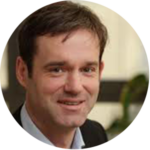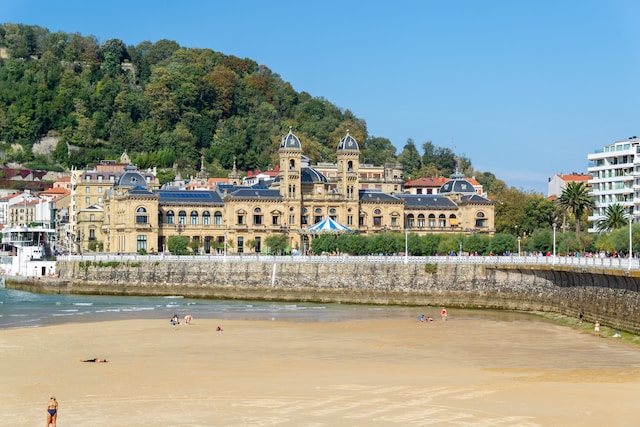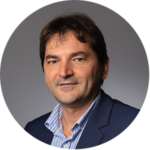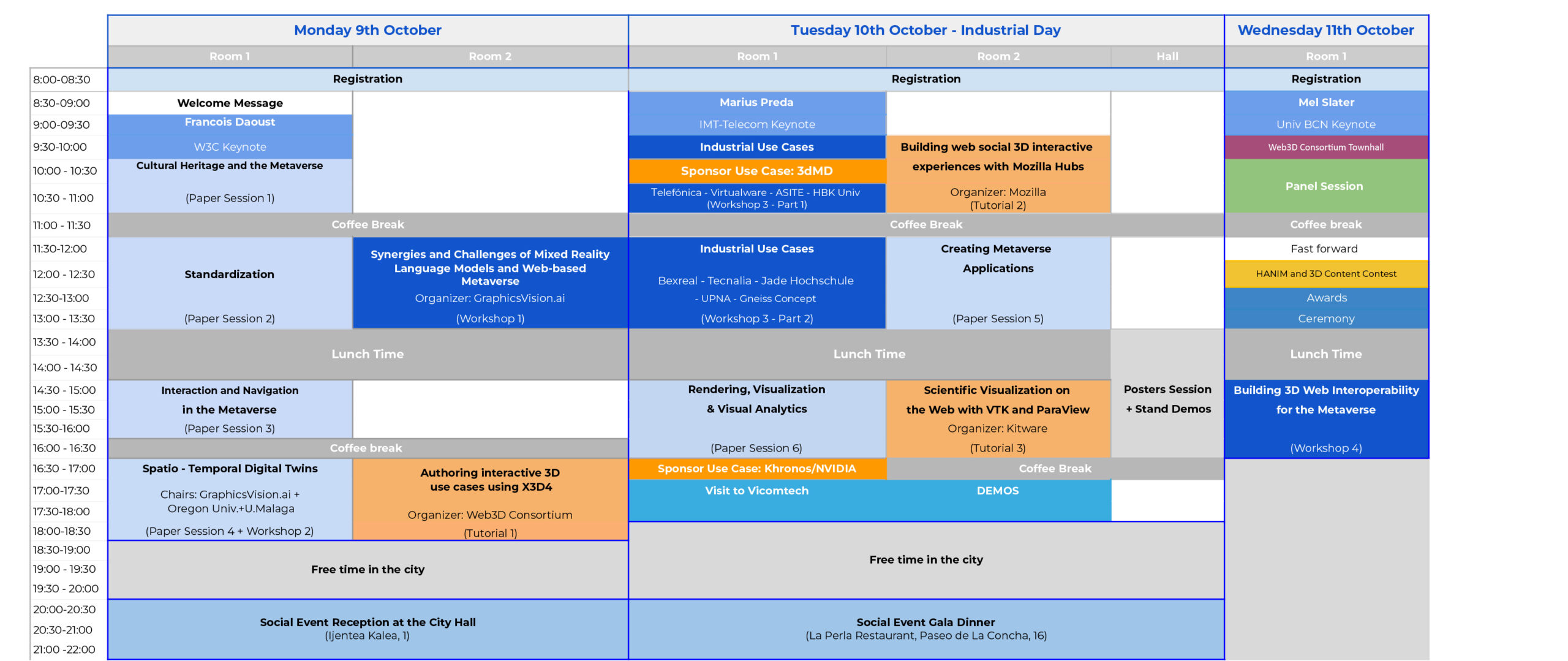Detailed Program
Important information for participants:
- Suggested template for Presentations (not compulsory), here
- Posters A0 format. Please include at least: authors, abstract, summary, results, some references, and web3D logo.
Monday, October 9th. 2023
PLENARY –  Room 1
Room 1

08:00-08:30 Registration
08:30-09:00
Welcome Message from the Conference Chair, Dr. Jorge Posada
Welcome Message from the Web3D Consortium, Exec, Dir. Anita Havele
09:00-10:00 KEYNOTE SPEECH – “W3C and immersive 3D worlds in Web browsers – Evolutions of the Web platform” ( Video, Slides)
 François Daoust. W3C Consortium
François Daoust. W3C Consortium
François Daoust is Media and Entertainment Champion at the World Wide Web Consortium (W3C), tracking and progressing activities of the W3C around the convergence between Web and media. This includes serving as W3C staff contact for the Media Working Group, Second Screen Working Group and GPU for the Web Working Group, exploring and organizing standardization workshops on topics of interest (Games on the Web, Professional media production), and liaising with other organizations on scenarios, needs, existing technical solutions, and identified gaps. W3C develops royalty-free technical specifications and guidelines for the Web. This standards work is accomplished in the open, with input from the broader community. Decisions are taken by consensus.
Keynote speech content:
The Web was created to connect people and share content. From a Web perspective, the notion of metaverse is a proposal to extend the Web platform to enhance user immersion. Creation of these new user experiences supposes that a number of building blocks are in place: 3D, spatial audio, virtual reality, augmented reality, computing capabilities, communications in real-time, etc. Work on these domains has been, and still is, a focus of the W3C in the past few years, leading to technologies, either still in progress or already standardized and supported across browsers, such as WebGPU, the Web Audio API, the WebXR family of specifications, WebAssembly, WebNN, and WebRTC. Combined with the universality of the Web with regards to people and accessibility of content, these enabling technologies make it virtually possible to create all sorts of immersive experiences on the Web.
There’s more to the Web than meets the eye though. Core principles of the Web platform include accessibility, internationalization, privacy, security, and availability across devices. To enforce these principles, access to Web content has always been mediated through a Web browser, also known as a “user agent”. The enabling technologies mentioned above are low-level though and leave users and Web browsers in the dark as to the content being represented. 3D on the Web is a canvas full of triangles. Virtual Reality on the Web is a pair of canvas full of triangles, coupled with tracking sensors that capture each and every user position. How can web browsers play their role of intermediaries in an immersive experience? How can the core principles of the Web continue to be guaranteed? What technical changes to core Web technologies are needed? Are we there yet?
![]() Room 1
Room 1
10:00-11:00 PAPER SESSION 1: “Cultural Heritage and the Metaverse”
Chair: Marco Agus (HBKU)
FP 9: “Tirtha – An Automated Platform to Crowdsource Images and Create 3D Models of Heritage Sites”, Jyotirmaya Shivottam and Subhankar Mishra
SP 16: “Web-based geolocated, teleoperated and interactive XR tours for cultural inheritance”, Guillermo Pacho Rodríguez, Bruno Simões, Breno da Costa Paulo and Ana Domínguez Fanlo
SP 20: “Venus in the bath – digital partial reconstruction of the shape of a roman statuette”, Felix Horn
![]() Room 3
Room 3
10:00-11:00 PRIVATE MEETING – GraphicsVision.ai
 Social Space – Hall
Social Space – Hall
11:00-11:30h ![]() COFFEE BREAK
COFFEE BREAK
![]() Room 1
Room 1
11:30-13:30 PAPER SESSION 2: “Standardization”
Chair: Sebastian Friston(University College London)
FP 17: “MORGAN: MPEG Original Reference Geometric Avatar Neutral”, Quentin Avril, Joao Regateiro, Philippe-Henri Gosselin, François Le Clerc and Philippe Guillotel.
FP 6: “Increasing Web3D Accessibility with Audio Captioning”, Nicholas Polys and Mohd Sheeban Wasi
FP 14: “Progressive Network Streaming of Textured Meshes in the Binary glTF 2.0 Format”, Wouter Lemoine and Maarten Wijnants
FP 40: “Conceptualizing I3S encoding for OGC CityGML 3.0 Building Model”, Rushikesh Padsala, Sanghmitra Banerjee, Tamrat Belayneh, Thunyathep Santhanavanich and Volker Coors
SP 25: “Combining FAIR principles and long-term archival of 3D data”, Matthieu Quantin, Sarah Tournon, Valentin Grimaud, Florent Laroche and Xavier Granier
![]() Room 2
Room 2
11:30-13:30 WORKSHOP 1: “Synergies and Challenges of Mixed Reality, Language Models and Web-based Metaverse” – GraphicsVision.ai

Coordinator: Prof. Didier Stricker. German Center for Artificial Intelligence (DFKI)
Presentation of activities of leading applied research groups belonging to the international network “GraphicsVision.ai”: German Center of Artificial Intelligence -DFKI-, Vicomtech, Centro de Computação Grafica, Hasso Plattner Institut, Fraunhofer Heinrich Hertz Institute, CGAII, Mivtech.
All GVAIN members will present their work and talk about the main synergies and challenges of combining Mixed Reality, Language Models, Avatars and Web-based Metaverse. e.g. topics related to EU project LUMINOUS, others.
Presentation by the GVAIN members and discussion with the audience after each slot
- 11:30 – 12:00: Responsive Realistic Virtual Avatars for the Metaverse (Prof. Peter Eisert, Fraunhofer HHI, Remote)
- 12:00 – 12:30: Exploiting Large Language Models for XR (Montse Cuadros & Arantza del Pozo, Vicomtech)
- 12:30 – 13:00: Orchestration of next-generation XR media services (Mikel Zorilla, Vicomtech)
- 13:00 – 13:30: Vision-based Situation Awareness and Continual Learning for XR Environments (Zeshan, DFKI)
 Social Space – Hall
Social Space – Hall
13:30-14:30h ![]() INFORMAL LUNCH
INFORMAL LUNCH
![]() Room 1
Room 1
14:30-16:00 PAPER SESSION 3: “Interaction and Navigation in the Metaverse”
Chair: Daniel Mejia (Vicomtech)
FP 29: “Building Virtual User Interfaces of Household Appliances for Marketing”, Paweł Sobociński and Krzysztof Walczak
SP 23: “MazeVR: Immersion and Interaction Using Google Cardboard and Continuous Gesture Recognition on Smartwatches”, Thamer Nascimento, Deborah Fernandes, Gabriel Vieira, Juliana Felix, Murillo Castro and Fabrizzio Soares
SP 33: “Integrating XR Content in X3DOM: Supporting Navigation and Custom Functions in X3D Scenes”, Raghav Sethi, Andreas Plesch, Timo Sturm and Nicholas Polys
SP 4: “Immersive Cross-platform X3D Training: Elevating Construction Safety Education”, Nazila Roofigari-Esfahan, Nicholas Polys, Ashley Johnson, Todd Ogle and Ben Sandbrook
![]() Room 3
Room 3
14:30-16:00 PRIVATE MEETING –GraphicsVision.ai
 Social Space – Hall
Social Space – Hall
16:00-16:30h ![]() COFFEE BREAK
COFFEE BREAK
 Room 1
Room 1
16:30-18:30 JOINT SESSION 4 (PAPERS + WORKSHOP 2) “Spatio-Temporal Digital Twins”
Coordinators: Prof. Jürgen Döllner, Prof. Raffaele de Amicis, Prof. Salvador Merino
WS 49: “Forests in the Digital Age: Concepts and Technologies for Designing and Deploying Forest Digital Twins”, Jürgen Döllner, Raffaele de Amicis, Josafat-Mattias Burmeister and Rico Richter
FP 28: “TwinArk: A Unified Framework for Digital Twins based on Micro-frontends, Micro-Services, and Web 3D”, Bruno Simões, Maria del Puy Carretero, Jorge Martínez Santiago, Sebastián Muñoz Segovia and Nieves Alcain
WS 19: “Towards Concepts for Climate and Energy-Oriented Digital Twins for Buildings”, Jürgen Döllner, Salvador Merino, Francisco Guzman, Javier Martinez, Juan de Dios Lara and Rafael Guzman
FP 11: “On Web Digital Twins: A use case for a Gerotor pump”, Juan Pareja-Corcho, Asier Pedrera-Busselo, John Ciarrusta, Aitor Moreno, Oscar Ruiz-Salguero and Jorge Posada
![]() Room 2
Room 2
16:30-18:00 TUTORIAL 1: Authoring interactive 3D use cases using X3D4
Coordinators: Mike McCann, Vince Marchetti and Doug Sanden
X3D version 4 is a major upgrade to the Extensible 3D (X3D) Graphics International Standard that supports HTML5 integration, advanced Physically Based Rendering (PBR) with glTF, Projective Texture Mapping (PTM), Humanoid Animation (HAnim2) and numerous other improvements. X3D4 provides powerful navigation and exploration aids, and combine assets from multiple sources in a single scene.
Through project case studies we will share how we find value in actively developing the Standard and tools to improve reproducibility and access to 3D worlds. The tutorial will touch on new features of X3D4 including, glTF support, PBR, Point Properties, Volume Data, MIDI and HAnim2.
We will present techniques for generating dynamic interactive 3D scenes visualizing the contents of vendor-neutral format file from domains of CAD, BIM, HANIM and Geospatial.
 City Centre
City Centre
18:00-20:00h Free Time in the City

20:00 – 22:00 Social Event Reception at the City Hall
![]() Ijentea Kalea 1 – City Hall, entrance from Alderdi Eder Park
Ijentea Kalea 1 – City Hall, entrance from Alderdi Eder Park
The Townhall of San Sebastian has organized a cocktail reception to the Web3D Attendees with light food in their beautiful main building, at the beginning of the internationally renowned “La Concha” Beach and besides the Old Town (“Parte Vieja”, famous for the many bars and restaurants offering “pintxos” and other culinary treats.
Tuesday, October 10th. 2023
PLENARY –  Room 1
Room 1
08:00-08:30 Registration
08:30-09:30 KEYNOTE SPEECH – “Compression factors for realistic 3D graphics” (Video, Slides)
 Prof. Marius Preda. Institut MINES-Telecom
Prof. Marius Preda. Institut MINES-Telecom
Marius Preda received the degree in engineering from the University POLITEHNICA of Bucharest Bucharest, Romania, in 1998, the Ph.D. degree in mathematics and computer science from University Paris V, Paris, France, in 2002, and the eMBA degree from the IMT Business School, Paris, in 2015.
He is currently Associate Professor with the Institut MINES-Télécom, Paris, and also the Convenor of the MPEG 3D Graphics and Haptics Working Group of ISO. He contributed to several international standards with technologies in the fields of 3-D graphics coding, virtual worlds, and augmented reality.
Keynote speech content:
For several decades, the compression of 3D graphics remained a compelling subject of research; however, its tangible impact on practical applications was limited. One predominant reason for this limited applicability was the relatively low resolution of 3D objects, primarily crafted by artists utilizing authoring tools. Recent innovations in capturing 3D scenes and objects, either as point clouds or derivative meshes, have substantially altered this scenario. Such content embodies an extensive data volume, posing challenges for its incorporation into mainstream applications. Yet, the straightforwardness in capturing and rendering their spatial details has escalated their popularity in immersive volumetric data representation.This discourse elucidates contemporary methodologies employed in the compression of realistic 3D graphic content, strategies that have been formulated during the MPEG standardization procedure for the compression of point clouds and dynamic meshes. The first method, termed V-PCC and designed for dense content, transforms the 3D space into 2D patches, leveraging conventional video technologies. In contrast, a second method, G-PCC – designed for sparse point clouds, navigates through the 3D space, generating octree predictors. Empirically, V-PCC attains a compression ratio of 125:1, an object with 1 million points needing a bandwidth of 8 Mbit/s. Concurrently, G-PCC achieves compression ratios up to 10:1 for lossless and 35:1 for lossy configurations. Additionally, a novel strategy focusing on dynamic mesh compression, which involves frame-by-frame simplification and refinements, is delineated. These standardized techniques hold promise in bolstering various domains, such as immersive media, virtual and augmented reality, real-time communication, autonomous navigation, and the preservation of cultural heritage. The talk introduces the perspectives of AI-based graphics compression, an emergent standardization project in MPEG.
![]() Room 1
Room 1
09:30-11:00 WORKSHOP 3: “Industrial Use Cases – Part I“
Mixed workshop between academia and companies working in Web 3D Technologies for Industrial Use.
Company presentations with Web3D related Technologies (no proceedings)
- Telefónica. “Horizon Worlds, Spatial, Movistar Immersive Experience”. Mikeldi Rodriguez
- Virtualware. “Virtual and Augmented Reality technologies and use cases”. David Moreno.
Industrial Use Cases (Proceedings)
- ASITE. “Geometry Streaming on 40 Leadenhall Street: A Case Study”, Sebastian Friston, Carmen Fan, Matthew Osment, Max Kidway and Jozef Doboš.
- Hamad Bin Khalifa University. “Immersive omnidirectional imaging for the development of Doha Design District at MSheireb Downtown Doha”, Shaikha Al Sulaiti, Jens Schneider and Marco Agus
![]() Room 2
Room 2
09:30-11:00 TUTORIAL 2: “Building web social 3D interactive experiences with Mozilla Hubs”
Manuel Martin, Mozilla Hubs Engine Team Engineer.
Topic of interest: VR/AR/MR/XR, HTML5 3D, WebGL, glTF, Education.
Subjects covered: We will learn how to design and create your own Hubs scene and avatar to host a meeting in a Hubs room. We will also briefly talk about how to extend the Hubs platform using typescript to add your own features to the platform
Learning objectives: The main objective is to introduce the platform, show what’s possible and get familiar with how to set up a Hubs meeting.
Intended audience: Anyone interested in using an open-source web-based platform to create 3D social interactive experiences
Prerequisites: No prerequisites
Level of difficulty: Easy
 Social Space – Hall
Social Space – Hall
11:00-11:30h ![]() COFFEE BREAK
COFFEE BREAK
![]() Room 1
Room 1
11:30-13:30 WORKSHOP 3: “Industrial Use Cases -Part II“
Mixed workshop between academia and companies working in Web 3D Technologies for Industrial Use.
Company presentations with Web3D related Technologies (no proceedings)
- Bexreal. “Mixed and Extended Reality for the Metaverse”. Javier Sordo
Industrial Use Cases (Proceedings)
- Tecnalia. “Exploring the Metaverse: Mixed and Virtual Reality for Collaborative Interaction in an electrical substation”, Igor Quintela, Pablo Aguirrezabal, Roberto Serrano, Gorka Barayazarra, Luis Conde
- Jade University of Applied Sciences. “Digitalisation in quality management – virtual fault localisation in the web browser using X3DOM”, David Roeskamm, Knut Barghorn
- Gneiss Concept. “Using LOA3 skeleton with Large size mesh, and SMPL weighting to X3D editing, the “Nitty, Gritty”. Carol McDonald, Katy Schildmeyer, Joe D. Williams, Don Brutzman,John Carlson
- Gneiss Concept. “Web 3D Overview for Apparel Industry”. Carol McDonald, Katy Schildmeyer, Joe D. Williams, Don Brutzman and John Carlson
- Public University of Navarra. “Demonstration of XR studio tools for creation of room-size immersive experiences within an extended reality environment”. Oscar Ardaiz, Xabier Olaz, Youssef Benbelkheir, Alvaro Lerga and Lucas Gasco Gonzalez (Poster invited to the industrial session)
![]() Room 2
Room 2
11:30-13:30 PAPER SESSION 5: “Creating Metaverse Applications”
Chair: Bruno Simões (Vicomtech)
FP 7: “Extending the Open Source Social Virtual Reality Ecosystem to the Browser in Ubiq”, Sebastian Friston, Ben Congdon, Nels Numan, Klara Brandstätter, Lisa Izzouzi, Felix Thiel, Jingyi Zhang, Daniele Giunchi, David Swapp and Anthony Steed
FP 30: “Immersive Learning in Engineering: A Comparative Study of VR and Traditional Building Inspection Methods”, Jordan Henstrom, Raffaele De Amicis, Christopher Sanchez and Yelda Turkan
FP 27: “PanoVerse: automatic generation of stereoscopic environments from single indoor panoramic images for Metaverse applications”, Giovanni Pintore, Alberto Jaspe-Villanueva, Markus Hadwiger, Enrico Gobbetti, Jens Schneider and Marco Agus
SP 36: “Advancing STEM Education in Primary Schools with an Integrated System of 3D Games”, Jeremi Ranosz, Cyryl Leszczyński, Stanisław Kumor, Agnieszka Popiel, Julia Głowaczewska, Patryk Garwol, Mateusz Kaczmarek and Mikołaj Maik
SP 21: “DrumsVR: Simulating Drum Percussion in a Virtual Environment Using Gesture Recognition on Smartwatches”, Pedro Gomes, Murillo Castro, Deborah Fernandes, Fabrizzio Soares, Gabriel Vieira, Juliana Félix and Thamer Nascimento
 Social Space – Hall
Social Space – Hall
13:30-14:30h ![]() INFORMAL LUNCH
INFORMAL LUNCH
![]() Room 1
Room 1
14:30-16:30 PAPER SESSION 6: “Rendering, Visualization & Visual Analytics”
Chair: Eric Wernert (Indiana University)
FP 2: “Real-world large-scale terrain model generation and real-time rendering”, Rui Li
FP 13: “Enhancing Decision Making in MDO through Interactive Visual Analytics on the Web”, Javier Henriques-Gil, Daniel Mejia-Parra and Bruno Simoes.
FP 41: “Web- and mobile-based Urban Bike Route Planner using Urban Regulation-constrained Delaunay Graph”, Juan Camilo Gutierrez-Urrego, Jorge Correa, Placid Ferreira, Saul A. Rivera and Oscar Ruiz-Salguero
FP 42: “Live Free-View Video for Soccer Games”, Islam Amar, Abdala El-Sana and Jihad El-Sana
SP 5: “Enhancing Brain Flow Visualization with Automated 3D Data Processing: A Study on DCE-MRI Data from Mice with Tumors”, Ayat Mohammed, Nicholas Polys, Jessica Cunningham, Jenny Munson, James Chutkowski, Hun Liang, Daniel Park, Russell Rockne, Ryan Woodaal and Cora Esparza
![]() Room 2
Room 2
14:30-16:30 TUTORIAL 3: “Scientific Visualization on the Web with VTK and ParaView”
Jules Bourdais and Julien Finet, Kitware SAS
This tutorial will present the different capabilities and specificities of the open-source libraries and applications such as VTK.js, ITK.wasm, Kitware Glance, VolView and trame. Also, it will explore in a hands-on way how to use trame to enable rapid web application development and prototyping by abstracting away the low-level details by writing only Python code.
![]() Social Space – Hall
Social Space – Hall
- 14:30-16:30 POSTER SESSION + STAND DEMONSTRATORS
Poster authors will present to the interested walking audience their works.
- CoEditAR: A Framework for Collaborative Interaction in WebXR-enabled Spatial Computing”, Mikel Salazar and Michael Nicholas Louka
- “Demonstration of XRStudio tools for creation of room-size immersive experiences within an extended reality environment”, Oscar Ardaiz, Xabier Olaz, Youssef Benbelkheir, Alvaro Lerga and Lucas Gasco Gonzalez
- “A gameified application to represent hand-drawn level curves in augmented reality”, Pauline Hengst, Abel de Bruijn, Rens Dur, Julia van der Kris and Beryl van Gelderen
- “Mid-air Contactless Haptics to augment VR experiences”, Íñigo Ezcurdia, Unai Fernandez, Xabier Olaz and Asier Marzo
- “Real-world terrain model generation and rendering”, Rui Li
Companies or institutions with Stands will also present their technologies to the walking audience
 Room 1
Room 1
16:30-16:45h SPONSOR PITCH
Gold Sponsor – Neil Trevett – Khronos/NVIDIA
 Room 1
Room 1
16:45 – 17:00h ![]() COFFEE BREAK
COFFEE BREAK
17:00-18:00 Visit to VICOMTECH Premises & Demos
 Optional Visit. Demonstration of highlight projects and technologies of our Web3D 2023 Host: VICOMTECH. As a leading applied research Centre in Spain, with over 220 people (70 Ph.D.), specialized in AI and Visual Computing Technologies, Vicomtech works closely with national and international companies in cutting edge applications for sectors such as Industry & Manufacturing, Intelligent Transport Systems, Security, Digital Health, Biomedical and many others.
Optional Visit. Demonstration of highlight projects and technologies of our Web3D 2023 Host: VICOMTECH. As a leading applied research Centre in Spain, with over 220 people (70 Ph.D.), specialized in AI and Visual Computing Technologies, Vicomtech works closely with national and international companies in cutting edge applications for sectors such as Industry & Manufacturing, Intelligent Transport Systems, Security, Digital Health, Biomedical and many others.
 City Centre
City Centre
18:00-20:00h Free Time in the City
20:00 – 22:00 Social Event – Gala Dinner
Wednesday, October 11th. 2023
PLENARY –  Room 1
Room 1
08:00-08:30 Registration
08:30-09:30 KEYNOTE SPEECH – “Multi-person shared virtual environments, and implications for the metaverse” (Video, Slides)
 Prof. Mel Slater. Universitat de Barcelona
Prof. Mel Slater. Universitat de Barcelona
Mel Slater is a Distinguished Investigator at the University of Barcelona in the Institute of Neurosciences, and co-Director of the Event Lab (Experimental Virtual Environments for Neuroscience and Technology). He was previously Professor of Virtual Environments at University College London in the Department of Computer Science. He held a European Research Council Advanced Grant TRAVERSE 2009-2015 and has now a second Advanced Grant MoTIVE 2018-2023. He is a Research Award Winner of the Alexander von Humboldt Foundation in 2021, and was elected to the IEEE VGTC Virtual Reality Academy in 2022. He is Field Editor of Frontiers in Virtual Reality, and Chief Editor of the Human Behaviour in Virtual Reality section.
Keynote speech content:
One of the most powerful uses of virtual reality is its support for remotely located people to meet together. Meeting in VR where each person is represented by a virtual body, which naturally exhibits body gestures, head turns, eye movements and facial expressions, where all the participants are in the same virtual space, is a very different experience from teleconferencing. People can maintain eye contact, gesture towards each other, change their physical proxemics relationships, take a walk together, almost as in reality. This talk will go over some of the history of shared VR, and also discuss developments that include meeting yourself, and interacting with celebrities. I will discuss the GuestXR project that combines virtual meetings with Machine Learning in order to address problems that may occur in virtual meetings, and ideas around the development of a Metaverse.
![]() Room 1
Room 1
09:30-10:00 Web3D Consortium Townhall
10:00-11:00 Panel Session
Shaping a Shared and Interoperable Metaverse
Our panelists are leaders from Industry, Standards development organizations and Research Institutes, who will debate and discuss the challenges for the metaverse to realize its potential and why must this Metaverse be built on standards and interoperability?
How best to make the Metaverse fully interoperable with the web, while combining the connectivity of the web with intuitive and trustworthy immersive experiences, and making user assets portable across different devices, domains and contexts.
Our Panelists:
Moderator: Prof. Nicholas Polys, Web3D Consortium/Virginia Tech – 3D Graphics and Visual Computing.
- Prof. Mel Slater, University of Barcelona – Virtual Worlds and Machine Learning for the development of a Metaverse.
- Dr Johannes Behr, Threedy.io
- Dr. Jorge Posada, Vicomtech & GraphicsVision.ai
- Tamrat Belayneh, ESRI, Bringing geospatial content to the Metaverse.
- Prof. Marius Preda, MPEG-4, Compression factors for realistic graphics.
- François Daoust: W3C Consortium – WWW perspective, extend the Web to enhance user immersion.
Join us as we learn from these experts and realize their vision and perspective on how to make the Metaverse successful this time around.
 Social Space – Hall
Social Space – Hall
11:00-11:30h ![]() COFFEE BREAK
COFFEE BREAK
![]() Room 1
Room 1
11:30-12:00 Showcase: Fast Forward
Web3D2023 Conference ends with a bang!.
3D Content and software developers and researchers, along with hardware producers, take the stage for a whirlwind tour of the latest Web3D features and applications. All real-time web-based 3D applications are welcome: Art, Science, Engineering, Medical, Cultural and Entertainment. Acceptance will depend on the number of submissions.
Applications welcome! Please fill the form
12:00-12:30 HANIM and 3D Content Contest
12:30-13:30 Awards Ceremony
 Social Space – Hall
Social Space – Hall
13:30-14:30h ![]() INFORMAL LUNCH
INFORMAL LUNCH
![]() Room 1
Room 1
14:30-16:30 WORKSHOP 4: “Building 3D Web Interoperability for the Metaverse“
This workshop will provide a platform for Industry, Metaverse Standards Forum (MSF), Standards development Organizations (SDO) and Browser developers to present and discuss how best to make the Metaverse fully interoperable with the WWW in order to enable new Metaverse capabilities. This workshop brings together participants from around the world with the goal of building a strong foundation for an open, interoperable Metaverse. The workshop will include presentations and discussions topics: Presentation Slides
- The nature of Metaverse Interoperability and paths to Interoperability
- The variety of relevant Standards and technology roles in the Metaverse stack
- The recently charted Metaverse Standards Forum (MSF) Working Group, “3D Web Interoperability”
- Scoping what the Metaverse IS NOT
- How Use Cases and Scenarios can help clarify what the Metaverse IS.
- SDOs engagement and Industry Support
In this emerging space and perspectives; we hope this Workshop will push our understanding and terminology forward and also provide the community with an actionable set of common referents and goals.
16:30 END OF CONFERENCE

